It was 1944, the apex of World War II, and on the home
front the Navy was keeping an eye on its Negroes. Twelve hundred worked at the Bremerton
shipyard, including 300 newcomers in the first eight weeks of the year. They were
angry because many businesses, including cafes, taverns, drug stores and barber
shops, displayed signs saying, "We Cater to White Trade Only." One of the dissidents
was 31-year-old Lillian Walker, whose husband worked at the shipyard. She was the
recording secretary of the Puget Sound Civic Society, a civil rights coalition formed
by the newly chartered Bremerton branch of the National Association for the Advancement
of Colored People.
Sixty-five years later, the centennial year of the NAACP found Mrs. Walker still
in the trenches. Her new hip was an aggravation, but at 95 she was spunky as ever
and checking her e-mail regularly. When she was young, she dreamed of becoming a
doctor, but she was born the wrong color and the wrong gender at the wrong time
in the wrong place. Still, there's no bitterness over the fact that she and her
late husband took on an assortment of part-time janitorial jobs for 40 years to
make ends meet and give their kids a better life. Someone once asked her, "Why are
you always smiling?" "Frowning and cursing," she replied, "that's not going to make
you any friends." A charter member of the Bremerton branch of the NAACP, she has
been "educating people," as she puts it, about racial equality for as long as she
can remember, and she remembers 1944 vividly. That was the year the civil rights
movement in Kitsap County began to get traction.
The Civic Society had been organized in the summer of '43, according to a confidential
report on the "Negro Situation" submitted to the Navy Yard commandant on March 6,
1944. Other declassified documents indicate the Navy was worried that communists
and radical unionists could be infiltrating the group and stirring up trouble. Robert
D. Addison, the group's president, worked at the shipyard. He agreed to talk with
the Navy investigators and "stated that from his observations the majority of the
negroes are highly dissatisfied and very much disillusioned because of existing
discrimination. He pointed out that these colored workers have come here at the
request of the government and the majority of them feel the government should make
a greater effort to make conditions more pleasant."
The Navy sent informants to a mass meeting sponsored by the Civic Society. The guest
speaker was Charles M. Stokes, a Negro attorney from Seattle who was on the threshold
of a remarkable career. Stokes called the whites-only signs wartime "morale sabotage"
and "particularly stressed the fact that white and colored people should be treated
equally." He urged the "approximately 250 colored persons" who attended the meeting
to protest discrimination in "an orderly and courteous manner." But if they were
still refused service by Bremerton businessmen, Stokes left "the impression that
he would be willing to take the matter to court to make a test case."
Impatient, some Negroes took matters into their own hands, the Navy Intelligence
Office noted. The Bremerton Police Department advised that on the night of February
6, 1944, "a maroon colored Dodge sedan containing a number of negroes was being
driven around town with the occupants throwing rooks (sic) at the windows of establishments
displaying such signs. Windows were broken at the Beach Cafe, Pop's Inn Tavern,
and the In and Out Cafe." Moreover, on February 18, 1944, Ozona Bonner, a black
woman employed as a sweeper at the Navy Yard, had slapped Ruth Green, a white employee,
in the women's locker room of Building 495. "It was reported that this negro woman
was standing in a crowded aisle when the white woman, carrying a number of packages,
passed through, bumping into her, following which the negro woman struck the white
woman in the face, causing her nose to bleed. For this act, the negress was suspended
for three days."
Lillian Walker has always tried to live "the Christian life," but she wouldn't have
turned the other cheek either. And if they had suspended her for three days, Attorney
Stokes would have been on the first ferry from Seattle. If you visit the bathroom
in her home, Mrs. Walker will ask with a mischievous smile if you took note of the
sign over the sink. It says, "You have a right to your opinion just as long as it
agrees with mine!" A former bookkeeper, her household was a tight ship. She's still
cooking on a 1947 Tappan Deluxe range. Every element and the oven are in good working
order and she's annoyed that she can't find someone to fix the clock.
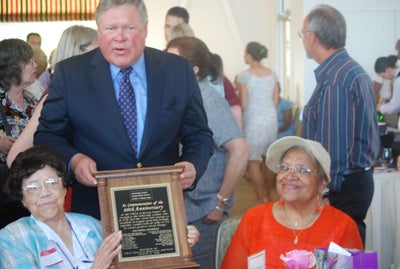 Congressman Norm Dicks presents Lillian
with the YWCA 60th anniversary commemorative plaque in 2008. She was the only living
founding member. Alyce Eagans is at right. Kitsap Sun
Congressman Norm Dicks presents Lillian
with the YWCA 60th anniversary commemorative plaque in 2008. She was the only living
founding member. Alyce Eagans is at right. Kitsap Sun
Although she claims she keeps forgetting things, they are rarely very important.
She does crossword puzzles, loves Scrabble and recalls addresses and other facts
with the facility of someone 40 years younger. She is tough, too, and for several
years walked around with appendicitis. She treated it with icepacks, a trick she
learned during her days as a nurse in a rural clinic. She won three bouts with diphtheria,
three more with pneumonia and endured 22 radiation treatments for uterine cancer
in 1982, using "humor therapy" to stay on the sunny side. She lost three children,
including twins, in pregnancy but sublimated her grief with her gumption and zest
for life. She is an icon in her community, with a host of friends who love and revere
her. Her congressman says she personifies community spirit; the candidates for mayor
want their signs in her yard.
Mrs. Walker never expected to live this long. In fact, she took Social Security
early at 62. "Sometimes now I pray, I ask God, 'What are you keeping me here for?'
And God says, 'You're doing it.' I say, 'What am I doing?' 'Well,' He says, 'you're
nice to everybody.' But I tell Him, 'I've always been nice to people.' "
Besides being nice, she is wise. She has been alive for nearly a century of American
history - and made history. There have been 17 presidents in her lifetime, from
Woodrow Wilson to Barack Obama. She met the 32nd, Franklin D. Roosevelt, and was
fighting for civil rights when Martin Luther King was in Junior High.
Dirt poor but proud
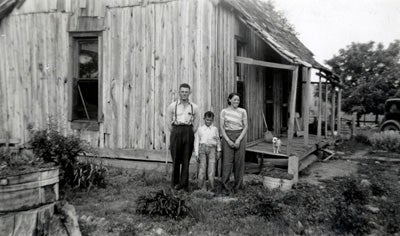 Lillian with her brothers, Lewis and
Ulysses, in 1940, outside the family home.
Lillian with her brothers, Lewis and
Ulysses, in 1940, outside the family home.
With an itinerant midwife and her grandmother assisting, Lillian was born at 4:30
a.m. on October 2, 1913, in a shack on a 20-acre farm near Carrier Mills in rural
Illinois. Her parents, Moses and Hazel Allen, were both of mixed race, "mulattoes"
in the parlance of the Census. Dad worked some of the time as a coal miner, but
most of the time as a farmer. The Allen abode was without electricity; water came
from a pump on the porch. The outhouse was out back - "way out back." When the Depression
hit in '29, they were already so poor - "dirt poor," as they used to say - that
they hardly noticed. Like her siblings, Lillian learned early on to plant, plough
and hoe, milk the cow, slop the pig, gather the eggs, chop kindling and rustle up
something for the stew pot. By 9, she could plunk a wild rabbit with a .22 rifle.
She walked barefoot to a two-room school that housed grades one through eight. High
school was three miles farther down the road, but the only time she got a ride was
when it snowed hard. Dad would then harness the horse and take her on the buckboard.
Her parents "insisted that we go to school. You didn't dare miss a day," Mrs. Walker
says. "We didn't play hooky. And in my family if you got a whipping at school, you
got a whipping at home."
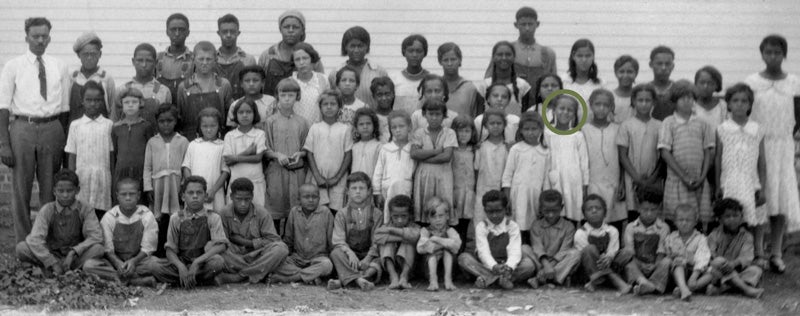 Lillian Allen (face circled) with the
students and faculty of the rural Illinois school in the 1920s.
Lillian Allen (face circled) with the
students and faculty of the rural Illinois school in the 1920s.
Her mother suffered a blow to the head at the hands of her stepfather for some perceived
insolence when she was in the fourth grade and was never able to read after that.
She would have Lillian read aloud to her from the newspaper, magazines or books
while she cooked supper. Forty years later, after she and Moses moved to Washington,
Hazel Allen was featured in a Seattle Post-Intelligencer article about Bremerton's
literacy program. An accompanying photo shows her listening intently to a tutor,
still striving to learn to read. She could proudly write her name and "count money"
like a champ because she kept close track of her egg sales. Lillian got her persistence
from her mother.
In all, Lillian's folks had 11 children, six of whom died young. Poor little Mary
suffered horrible burns after playing too close to the fire; Charles was 2 or 3
years old and sleeping in the same bed with Lillian when he awoke choking. They
put a spoon in his mouth to try to clear the airway, but the toddler died before
the doctor traversed the 12 miles from Harrisburg. A few years later, Lillian was
"so excited to have a little sister," but Juanita lived only a few hours. Flora
Belle succumbed to an unremembered childhood illness and William died of measles.
Next came Brenda Iris, who died in infancy. Happily, the last, James Franklin, survived
childhood. "Lord knows, life was hard," Mrs. Walker says. "Think of my poor mother.
… But they were never negative! Mom always encouraged us, and Dad always said, 'You
can do anything anybody else can do.' And I always said, 'I can do anything you
can do, only I can do it better.' "
As to color, some of the fascinating faces in Mrs. Walker's family album look white.
Others range from clearly to vaguely African-American, although all are light-skinned,
like Lillian. Her father's mother, Grandma Elvira Allen, was mixed-race, the granddaughter
of a Tennessee slave owner. According to family lore, his daughter's husband departed
the plantation, possibly to deal in slaves, and never returned. The daughter lapsed
into an illicit relationship with "a Portuguese man who lived on the plantation."
He may have been a slave or himself a slave trader. The clear inference is that
he was not white, and calling him Portuguese may have been an attempt to sanitize
the scandal. But the fact is, Portugal once had a far-flung colonial empire and
in the mid-1400s began importing thousands of black slaves, many of whom in due
course intermarried with whites. It was one of the world's leading slave traders
until late in the 18th Century.
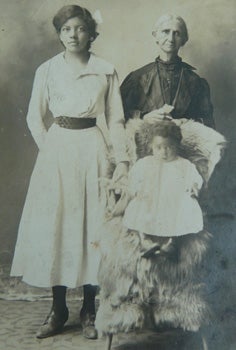 Lillian's grandmother Elvira Allen
around the turn of the century with two young relatives.
Lillian's grandmother Elvira Allen
around the turn of the century with two young relatives.
The plantation owner, meantime, was also enduring financial problems, presumably
as the Civil War storm clouds gathered. He was tempted to sell his daughter's eight
illegitimate children as slaves. "Fearing this action by her father," the story
goes, she and her "Portuguese" partner fled to Illinois, where they could live free
and homestead. There, they were married, some 20 years after they first met. Their
daughter, Elvira, born in 1849 - 12 years before the start of the Civil War - grew
to young womanhood near the colored community of Lakeview. It was a wide spot in
the road where free blacks had settled, a dusty mile from Carrier Mills. Willis
Allen was her second husband. We know little of his lineage except that he had a
black father and a white mother.
Lillian Walker has a photo of Grandma Elvira, long-necked and dressed in black but
looking white. She offers a thin smile and melancholy eyes. She's posing with a
beautiful young mixed-race woman and a curly-haired black boy who looks to be about
1. Mrs. Walker has forgotten the identities of the young woman and child, but surmises
that it's a generational photo - grandma with a great-grandchild and a grandchild
or niece.
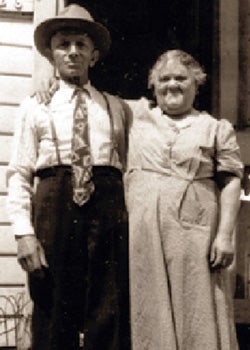 Moses and Hazel Allen
Moses and Hazel Allen
A Depression-era photo of Mrs. Walker's parents is an American Gothic classic. If
one picture is worth a thousand words, this one speaks volumes. Hazel Allen, a hefty,
salt-of-the-earth character in a house dress, has her right arm affectionately draped
over Moses' shoulder. He's wearing a hat, a white shirt, a go-to-church tie and
his best trousers, hiked up by suspenders. "Mose" and Hazel were often mistaken
for white, and it's easy to see why.
Lillian's late husband, James T. Walker Sr., a shipyard electronics inspector, was
the grandson of slaves who "jumped over the broom" to formalize their marriage in
Virginia. (Some scholars believe the tradition is rooted in African symbolism.)
When he heard that Lincoln had signed the Emancipation Proclamation, James' grandfather
exclaimed, "Now I'm a man!"
In her lifetime, Lillian Allen Walker has seen America move from lynching Negroes
to electing them to its highest offices. Through it all, she has never stopped wondering
why race matters. "I don't see color," she says. "I see each person as an individual."
To paraphrase a quip by President Obama, she sees herself as an All-American "mutt"
- and she's proud of it.
A fighter
Mrs. Walker signed on as a custodian at the Bremerton Navy Yard in 1941. A woman
in personnel insisted on giving her two ID badges, one Filipino, one white, because
she wasn't sure what race she was. With all due respect to Filipinos - and Caucasians
- that struck Lillian as preposterous. "I told her I was a Negro - that I wasn't
going to wear a Filipino badge. … People told me, 'You could have passed (for white).'
But why should I? I've always been proud to be who I am … I'm colorblind. I tell
people, I have as many white friends as I have black friends. I've always tried
to treat people like I want to be treated. I don't care what color you are as long
as you're a good person. I've never understood prejudice, and I've never put up
with it. I always said, 'Well, you're either with me or against me. And if you're
against me, that means we're going to have to fight!' "
 Rosa Parks, who in 1955 refused to
surrender her bus seat to a white passenger in Montgomery, Alabama, ushering in
the modern civil rights movement. Martin Luther King Jr. is in the background. National
Archives
Rosa Parks, who in 1955 refused to
surrender her bus seat to a white passenger in Montgomery, Alabama, ushering in
the modern civil rights movement. Martin Luther King Jr. is in the background. National
Archives
On a trip to Louisiana in the 1940s to visit her husband's relatives, she nearly
lost it. "I had gone to the store to buy a pair of hose, and the clerk stopped waiting
on me when a white person came in," Mrs. Walker recalls. "I went out and waited
in the car. And I said to James, 'Would you get me out of this town because otherwise
I'm going to kill somebody?!' " A few years later, however, after they'd won some
desegregation battles in the courtroom, she was more inclined to stay the course.
James came home from the shipyard one night and said the Navy wanted to send him
down South for a while, "but I hate to take you down there, honey." "Don't worry
about that," Lillian said. "We'll either straighten out the town or we'll move!"
As fate would have it, the Walkers stayed to straighten out Bremerton. James was
with Lillian every inch of the way as they fought discrimination and worked on multiple
fronts to make it a better city. But if they had moved South, they surely would
have been in the thick of the brutal civil rights struggles there, marching with
Dr. King and staging sit-ins. Kindred souls, Lillian Walker and Rosa Parks were
born the same year. Anyone who has met Lillian can easily imagine her on that bus
in Montgomery, Alabama, on that fateful day in 1955 when Rosa refused to surrender
her seat to a white man. Lillian and Rosa were both active in the African Methodist
Episcopal Church. They resemble one another physically as well. But Lillian Walker,
a spitfire when provoked, might have socked the bus driver had he dared lay a hand
on her.
Three pillars
Growing up, the three pillars of Lillian's life were home, school and church. The
Allens preferred the Baptist Church or the Methodist Church over the Holy Sanctified
Church, a Pentecostal movement born among slaves. The Sanctified parishioners were
prone to shouting out their joy as the spirit moved them. Lillian's faith has always
been deep and abiding, but she gets irked by "hollering and shouting … because you
can't understand what the preacher's saying." She says you always wore your Sunday
best to church. "We'd walk barefoot up to church, and take towels to clean our feet,"
she recalls. "We would sit down on the church lawn and put our shoes on and then
we'd go into the church." At mid-week, they'd be back for Bible Study.
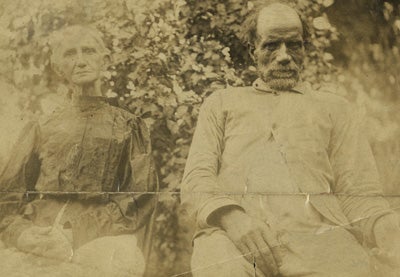 Grandma Elvira and Grandpa Willis Allen,
who came to live with his son's family after his wife died.
Grandma Elvira and Grandpa Willis Allen,
who came to live with his son's family after his wife died.
After Grandma Elvira died, Grandpa Willis Allen came to live with Lillian's family.
In the summertime, the kids were charged with keeping the flies off him as he sat
on the porch in the lethargy of elderliness. One day he slumped over from a stroke
and the children ran inside to declare, "There's something wrong with grandpa!"
The doctor came as soon as he could. "Grandpa lasted about three days and then he
was gone," Lillian recalls. Poor people were familiar with the fragility of life
and weren't given to complaining. Folk remedies treated a myriad of ailments. "If
we had a toothache, and if it had a hollow in it, Dad would either put a piece of
carbide in it - you know, what the coal miners used - or pull it because we couldn't
afford a dentist," Mrs. Walker recalls.
"You couldn't go to school until you were 7," and Lillian could hardly wait. Then,
because her birthday is in October, they told her she had to wait until she was
nearly 8. She read books by the light of a kerosene lamp at the "study table." When
she was in the third grade, she and her brothers were the only colored kids. One
day, a white girl named Helen called her a nigger. Lillian calmly handed her books
to a white chum, Dimple Edwards, and bopped Helen in the nose. Helen never again
called her that. In fact, they became best friends. Nor was there any boy "that
dare tackle me or say something nasty to me because I'd beat him. … I was raised
with brothers and we rassled." She was smart, too. When she was promoted to ninth
grade in 1930, her teachers noted that her work was "exceptional" in every subject.
Harrisburg, where her Dad worked sporadically at the coal mine, was about 12 miles
away. On Friday, Mom, Dad and the kids would pick vegetables - "beans, peas, potatoes,
whatever" - and Dad would take the produce into town to sell. He'd often stay overnight
at the miners' bunkhouse. "He came back home one Saturday evening and said he hadn't
sold anything. Mom said, 'What happened?' And he said, 'People don't have any money.'
So we had to can that stuff or eat it. That was the first time that I realized (there
was a Depression in America). We didn't realize we were poor." At Christmas, each
child might get an orange or new pair of socks Mom had knit.
Don't breathe!
After graduation from Carrier Mills High School, Lillian "knew we couldn't afford
college," but if she couldn't be a doctor she at least wanted to be a nurse. She
was hired at the 13-bed Lewis Home Sanitorium in Harrisburg and worked her way up
from flunky to ad hoc anesthesiologist, taking correspondence courses in nursing.
Skeptical at first that she just wanted to earn money to buy Easter clothes, J.H.
Lewis, the black physician who owned the clinic, soon realized Lillian had a natural
aptitude for medicine. She wasn't the least bit squeamish about blood and other
bodily fluids. Surgery, in fact, fascinated her. She learned to handle every increasingly
important task with painstaking attention to detail. Friends would ask, "Doesn't
the blood bother you?" And she'd say, "No. They could cut your head open, and then
go and sew it back on. It's fine with me." One day they brought in a young man who
had been practically scalped in an automobile accident. Lillian was unfazed as they
methodically cleaned the wound and sewed his scalp back on. The doctor was impressed.
"He was a good teacher," Lillian recalls, "and I really got training. The only time
that I messed up was one time when I was giving ether to a patient. 'Breathe in,
breathe out, breathe in,' I said, and the ether put me to sleep. I learned after
that that you don't breathe when you're giving ether!"
When she departed for Chicago after two and a half years, Dr. Lewis gave her a glowing
letter of reference: She "performed her duties very satisfactorily," including "practical
nursing, office assistant, cooking, dietetics, urinalysis, taking blood pressure,
assisting in operations, either giving ether or serving in capacity of operative
assistant" as well as overseeing post-operative care. "She has demonstrated a willingness
to work hard and a fine type of intelligence, which coupled with her natural interest
in medical work, should fit her for a successful career in nursing."
It was in 1937 that she went to live with her father's sister, Aunt Carrie, and
work for a family as a nurse and maid. She delighted in the bustle of the huge city
and loved going to museums and "all the educational things." Then she met a young
musician with a thousand-watt smile: James Titus Walker. He was raised by his grandmother
in Future City, Illinois, a suburb - to use that word loosely - of Cairo. Future
City was falling way short of living up to its name, and Cairo was a Mississippi
River town where racism was rampant. James left town after the 10th grade to live
in Louisiana with his mother and his stepfather, who taught him to play the saxophone.
After completing high school, James joined his stepfather's five-piece band. A naturally
talented musician, he ended up traveling widely before landing in Chicago.
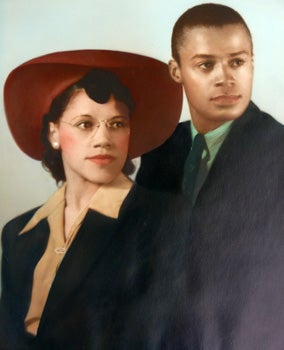 Lillian and James Walker on their wedding
day in 1941.
Lillian and James Walker on their wedding
day in 1941.
They were a handsome couple. James was 27, Lillian 25. He was quiet but quick-witted.
She was confident and assertive. He loved her and she loved him, "but I told him,
'I'm not going to marry a musician. I am not going to starve to death! Well, I can
get work, but I'm not going to marry a musician.' And he said, 'Well, honey, I'm
looking for another job.' "
Come 1940, James' mother was living in Seattle, where Boeing and the shipyards were
working up a full head of steam. While pledging "your boys are not going to be sent
into any foreign wars," FDR was transforming the U.S. into "The Arsenal of Democracy"
to aid Great Britain as the Nazis subjugated Europe. James arrived in Seattle that
November and lined up the promise of a job at the Navy Yard or Ammunitions Depot
in Bremerton by spring. He found work as a laborer at an Army storage depot for
$6 a day, signed up for the Merchant Marines, just in case, and sent for Lillian.
A well-to-do couple in Longview needed a gardener, chauffeur, cook and maid. James
and Lillian filled the bill and worked there until May when the Navy called. They
were married in Seattle and arrived in Bremerton on June 20, 1941, with everything
they owned in a shopping bag. Nannie Jones, a black lady, had a room for rent.
Welcome to Bremerton
The city was on the threshold of stunning growth and culture shock. Bremerton's
population zoomed from 15,000 in 1940 to 75,000 by 1944, elevating it to the state's
fourth largest city. The newcomers were pitching tents, sleeping in cars, on park
benches, even in chicken coops. Shipyard workers coming off the graveyard shift
were bumping others out of boarding-house bunks. They called it "hot bedding." It
was so crowded in Bremerton that many workers commuted from Seattle on the Kalakala,
the legendary streamlined ferry. Seattle grew from 368,000 to 530,000 in the same
time period. In all, some 600,000 migrants flocked to Washington's cities and towns
to do war work, thousands of them blacks from the South and Urban East. Uncle Sam
poured $40 billion into the West Coast. Per capita income in the state soared, even
with 41 percent population growth factored in.
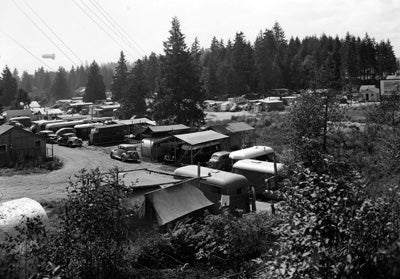 War-time workers lived in trailers,
shacks, even chicken coops, as they poured into Bremerton in 1942. Note the barrage
balloon on the horizon. The balloons were tethered to the ground by steel cables
that could slice the wings off low-flying enemy aircraft. Puget Sound Navy Museum
War-time workers lived in trailers,
shacks, even chicken coops, as they poured into Bremerton in 1942. Note the barrage
balloon on the horizon. The balloons were tethered to the ground by steel cables
that could slice the wings off low-flying enemy aircraft. Puget Sound Navy Museum
World War II did what all of the Roosevelt Administration's alphabet agencies -
the NRA, WPA, TVA and CCC - couldn't achieve: It ended the Great Depression. It
also changed the face of the Evergreen State, demographically and industrially.
"Between Pearl Harbor and VJ day in August of 1945, the industrial framework of
Washington took its modern form," Robert E. Ficken and Charles P. LeWarne note in
Washington, A Centennial History. "Employees of sawmills and logging camps declined
from 46 percent of the workforce in 1939 to 17 percent in 1944. In revealing contrast,
shipyard employment increased from 1 percent to 32 percent."
Bremerton was home to about 100 blacks in 1940, according to the U.S. Census. By
the summer of 1944, about 4,600 were working for the military at the Navy Yard,
the Ammunitions Depot and the Torpedo Station. Uncle Sam had a far better track
record of hiring blacks than Boeing or the civilian shipyards. Dianne Robinson,
a Bremerton City Council member who is the founder and curator of the Black Historical
Society of Kitsap County, believes there were upwards of 10,000 blacks in the county
at the peak of the war - as many as in Seattle. The Census data is of little use
because the war fell between its enumerations in 1940 and 1950, and the yearly estimates
lack demographics. In any case, Robinson doesn't trust black demographic data from
that era. "At one time, black people wouldn't even talk to Census people, or they
would give them really negative (or misleading) information. They were afraid to
really say how many people there were in a household. … Not only that but we have
to include blacks in the military stationed in Kitsap County and the workers' families."
"A hastily formed housing authority" steered the blacks recruited by the Navy into
segregated projects - Sinclair Heights in Bremerton and Orchard Heights in Port
Orchard. Robinson says there were about 280 black housing units in all, plus the
"Duration Dormitories" for single workers. Once unpacked, black workers promptly
wrote to family and friends from Florida to Texas, thousands of whom headed for
Puget Sound. "I know of three families that lived in one side of one of those duplex
units," Robinson says. "That's how they did it. Family and friends followed the
workers who arrived, all of them coming for an opportunity … to make some money.
They were really packed into a lot of those units."
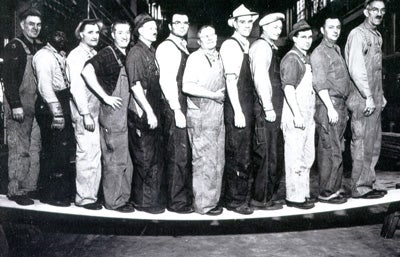 A black man poses with fellow shipyard
workers during World War II. Puget Sound Navy Museum
A black man poses with fellow shipyard
workers during World War II. Puget Sound Navy Museum
Especially for blacks bogged down in the South, World War II provided an opportunity
to enter the workforce, learn a trade and lead better lives. Most who headed west,
including Lillian and James Walker, never imagined they would encounter racism in
what seemed to be a land of opportunity. But Jim Crow was here, too, together with
trade union resistance to integration, never mind that there was a war on. The Aeronautical
Mechanics Union local and Boeing management stonewalled the hiring of blacks - and
white women - despite the growing need for war workers and President Roosevelt's
1941 executive order calling for fair employment practices in labor and industry,
historian Polly Reed Myers has documented. Union men feared that white female and
minority membership would "bring down wages and hinder union effectiveness." Blacks
and whites worked together with less animus at the Bremerton Navy Yard, but the
Negroes there knew that moving up to plum jobs would be tough.
Racial tension in defense industries and the migration of job-seeking blacks to
cities sparked race riots in 1943 in several American cities, including Los Angeles.
One of the shades-of-gray ironies is that blacks from the North were sometimes critical
of blacks who arrived from the Deep South. In Bremerton, some whites drew that distinction,
too, maintaining that the Southern Negroes - accustomed to more prejudice and generally
less educated - were often rude or otherwise uncouth, just "not as nice" as the
other Negroes. Mrs. Walker says she saw some of that herself and remembers shaking
her head at the newcomers' bad manners.
Rough and tumble
The bigots in Bremerton likely were a vocal minority, part of the shipyard city's
wartime growing pains, but there were a lot more than a handful. Bremerton had been
a rough and tumble town practically from its birth at the turn of the century, with
a "notoriously loose moral tradition." In 1942, it was over-dosing on testosterone
and cheap beer. Six dance pavilions, a dozen brothels, miscellaneous freelance hookers
and hundreds of proverbial drunken sailors crowding taverns and tattoo parlors added
up to relentless trouble. The Police Department had a dozen men in 1940 and 54 at
war's end. Often that wasn't nearly enough, The Kitsap Sun recalled in
2001 when the city observed its centennial. "Stories of people being robbed on the
streets and public fights made news on a daily basis by 1945. … That year, 400 sailors
'rioted' in a 'near mob scene' near the ferry terminal … and it took 12 officers
to subdue the melee, the result of a series of fights." Teenage girls had a 10 p.m.
curfew, and Chief Art Morken "regularly warned the populace of the dangers of unattended
adolescents, who often had both parents working, or a mom at work and a dad overseas."
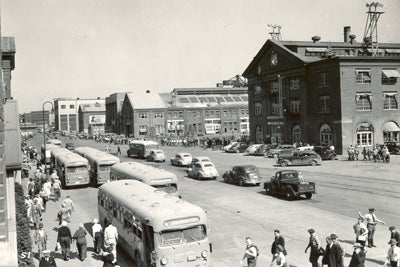 Busy Farragut Avenue in Bremerton during
World War II. Puget Sound Navy Museum
Busy Farragut Avenue in Bremerton during
World War II. Puget Sound Navy Museum
The good news was that when the black folks began to assert themselves, some righteous
white people joined the cause. One was the Walkers' neighbor, Ron Johnson. He had
a gun that he vowed to use if anyone attacked Jim and Lillian for daring to expect
equality. Another was Peggy Gustafson, who stood shoulder to shoulder with Lillian
when she was refused service at a downtown cafe.
Chief Morken is also fondly remembered by Bremerton's longtime black residents,
but he had his hands full. His crowded town never slept. When Sinclair Heights and
four other federally-financed housing projects were annexed to the city in 1943,
the chief had another 16,000 citizens to serve and protect and miles more turf to
patrol. Morken had advanced from traffic cop to captain in the space of seven years
and was named acting chief in 1942 at the age of 33 when Chief Charles "Slats" Lewis
went off to war. The average age of the department was 31. To deal with the volatile
nightlife downtown, Bremerton Police "have gone back to an era almost forgotten
when night sticks were badges of authority," Sheriff & Police Reporter magazine
noted in 1943. "The department has one of the state's most serious traffic situations,
the result of narrow streets and the thousands of war workers who, three times daily,
pour in and out of the Navy Yard. During peak traffic hours, 15 officers are assigned
to principal intersections to alleviate the congestion."
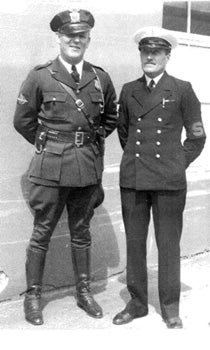 Bremerton police chief Art Morken,
left , with the chief of the Navy Shore Patrol during World War II.
Bremerton police chief Art Morken,
left , with the chief of the Navy Shore Patrol during World War II.
Bremerton Police Department
In the midst of all that, Morken was affable and fair-minded - "a very nice white
man," according to Mrs. Walker. He earned their enduring respect by prodding business
owners to realize that with so many blacks arriving in town, racism was not only
wrong, it was going to hit them in the pocketbook. Ed Bremer, whose German immigrant
father founded the city at the turn of the century, did what he could to help, opening
a beer parlor called The Casino especially for blacks. It offered food, drinks and
dancing - "a place where you could go and feel comfortable," Lillian says.
James and Lillian worked at the black USO Club in the Labor Temple, one of the few
places with a welcome sign for African American service men. Racism was rampant
in the military, and the Shore Patrol and shipyard guards often looked the other
way. In March of 1945, The Northwest Herald, a black newspaper in Seattle, reported
that two black defense workers in Bremerton had been chased out of the New China
cafe by five Marines. "They proceeded to beat and abuse Junior Howard, who was not
fortunate enough to escape them as the other. When he was finally loosened" they
spotted Edward Barnett , another resident of the nearby black dormitory. They "caught
up to him just outside the Navy Yard gate. … In plain view of the guards on the
gate, the Marines, who by this time had increased to seven, beat him, crushing his
eyeglasses, giving him an ugly cut over his eye and breaking a bottle of liquor
on his back … They then disappeared through the gate into the Navy Yard. Barnett
had to have nine stitches taken." The paper headlined the story "Nazism in Bremerton."
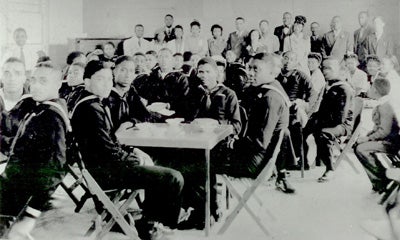 The Black USO Club at the Bremerton
Labor Temple during World War II. Black Historical Society of Kitsap County
The Black USO Club at the Bremerton
Labor Temple during World War II. Black Historical Society of Kitsap County
One morning, utterly without provocation, two sailors jumped James Walker. Lillian
was working inside the Tower Theater and James was mopping the entrance. Another
"real good cop," Officer Ben White, happened by and collared the attackers, who
sputtered that he must be a "nigger lover." Woolworth's lunch counter also discriminated
against blacks on into the 1950s, and was the site of NAACP sit-ins. "Bremerton
was a white supremacist town," Mrs. Walker says. "I'd never experienced anything
in Illinois like we encountered when we came here."
Civil rights law, meantime, was a paper tiger in Washington state. The 1890 Legislature,
imbued with Populism and recoiling from the virulent anti-Chinese riots of the mid-1880s,
passed a Public Accommodations Act that granted "all persons within the State of
Washington … of whatever race, color or nationality … full and equal enjoyment"
of hotels, theaters and restaurants, as well as trains, boats and coaches. Infractions
were punishable by fines ranging from $50 to $300 or 30 days to six months in jail.
However, the 1895 Legislature turned conservative in the wake of The Panic of '93,
which hit America every bit as hard as the recession of 2008-09. It removed the
penalties from the Public Accommodations Act. The move went largely unchallenged
for years because prior to World War II, there had been few Negroes in Washington
State - 2,500 at the turn of the century and still only 7,400 in 1940. When the
throng of newcomers to Puget Sound encountered racism, they mobilized. James and
Lillian Walker and their dear friends, Elwood and Marie Greer, Loxie and Alyce Eagans
and Gertrude Joseph were indefatigable NAACP members.
The Triangle Café near the entrance to the Navy Yard was the scene of a notable
"sit-in" in the 1940s, or to put it more accurately, a "stand-outside." After an
NAACP meeting, Lillian, her friend Peggy Gustafson and another white lady stopped
for a bite to eat. Lillian tells the story of what happened: "We sat down and the
waitress asked Peggy what she wanted. Peggy told her, 'I'll have whatever Mrs. Walker
is having.' So I said, 'I'd like a piece of pie and a cup of coffee.' " The waitress
turned on her heel and ducked around the corner. "So I got up and followed her around.
I said, 'I told you I wanted a piece of pie and a cup of coffee.' She said, 'Well,
I've only got two hands!' I said, 'Well, you're not using either one of them. What's
your name and your phone number? And what's your boss's name?' Well, she darted
right out the door. There was a telephone booth right in front of the restaurant.
And my brother, Ulysses, who was 16 years old, was standing next to the phone booth
waiting on the bus to come home because he worked at the YMCA." Surmising that his
big sister was at it again, he looked on as the flummoxed waitress called the cops,
warning that there was about to be a "race riot."
The rioters stood outside in calm solidarity. Chief Morken arrived on the double,
interviewed the witnesses and opined that a diminutive black lady ought to be able
to have a piece of pie with her friends in Bremerton. He arranged a meeting the
next day with the president of the NAACP, the pastor of Ebenezer A.M.E. Church and
the café owner, who decided to remove his "We serve whites only" sign. Lillian Walker
and her growing circle of friends and admirers had done some more "educating."
The Bremerton branch of the NAACP played a leading role in a statewide struggle
that took another 25 years to achieve lasting victories. From dime stores and bus
stations, soda fountains and barber shops during the war years, the state's civil
rights pioneers moved to the halls of the state Capitol to press their case for
equal rights. Forging coalitions with progressive unions, ministerial associations
and service clubs, they formed "Civic Unity" and "Civic Society" committees. James
Walker was the second president of the Bremerton branch of the NAACP, and Lillian
was the secretary. She well remembers addressing 500 postcards every month and going
door to door to recruit new members and urge people to register to vote. Lillian
went on to become state secretary of the NAACP and one of Kitsap County's most stalwart
Democrats. The Walkers were both active in the push for a Fair Employment Practices
Act, which was enacted by the Legislature in 1949.
Bremerton schools were a bright spot in the civil rights picture. While there were
few black teachers in the 1940s when the Walkers arrived, the staff and administrators
were generally progressive. Mrs. Walker remembers only one incident. Ulysses arrived
from Illinois in 1943 to live with them. Soon thereafter he came home from school
uncharacteristically glum. Lillian knew something was wrong. It turned out that
his teacher had used racial epithets in the classroom. The next morning, Lillian
marched down to the school, took the woman aside and warned, "If it happens again,
I'll have your job. I know your boss doesn't believe in that." The teacher said,
"Yes, Mrs. Walker."
Lillian in action was something to behold. Soon after they arrived in Bremerton
James needed a haircut, so they stopped at a shop not far from the shipyard. The
barber, who was white, told James, "Well, if you come back after 5 o'clock, we'll
close the shades and I'll cut your hair." Lillian was outraged. "If he couldn't
cut a black man's hair in bright daylight, there was no way we were going to go
there. So I said to James, 'Excuse me, honey, you will not be back after 5 o'clock.
We will not go anyplace that the shade is closed. No, if you're going to cut his
hair, you'll cut it right now, because if you don't cut it, I will cut it when I
get home because I am a barber.' I had been trained as a barber back in Carrier
Mills." From then on, she cut James' hair, James Jr.'s hair and her brothers' hair.
Lewis Allen had also moved from Illinois to Bremerton and landed a job at the shipyard.
On May 3, 1943, the Walkers moved into the house where Lillian still lives. The
price was $3,300, and they endured a lot of rigmarole about insurance and the down
payment. The banker's name, ironically, was Walker. Finally, a white real estate
man offered to loan them the down payment. "Do you know what you're doing?" said
the banker. "Yes," said the real estate man. "I trust Mr. and Mrs. Walker. They
said they'd pay me and I believe them." He was a "very kindly white man," Mrs. Walker
recalls. "People were impressed by our attitude. And we paid him back, every month,
right on time."
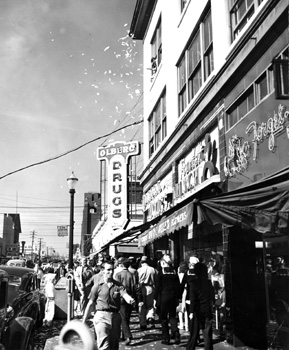 VJ Day crowds in front of Forget-Me-Not
Florists and Olberg Drugs at Pacific and 4th on August 14, 1945. Confetti flutters
from the third floor windows.
VJ Day crowds in front of Forget-Me-Not
Florists and Olberg Drugs at Pacific and 4th on August 14, 1945. Confetti flutters
from the third floor windows.
Puget Sound Naval Shipyard
Boeing B-29's dropped history's first A-bomb on Hiroshima on Aug. 6, 1945, and reduced
Nagasaki to radioactive rubble three days later. V-J Day came on Aug. 14. The Bremerton
Sun's front page featured that good news and the bad news that $6 billion worth
of Navy contracts had been canceled. There was a mass exodus of blacks and 22,000
workers in all. Blacks who stayed found themselves foreclosed from certain jobs
and saw their wages lag behind whites. But the Walkers had too much emotional equity
in Bremerton, too many friends, to pick up and leave. Besides, James was moving
up at work.
The NAACP lost members, but it was still energetic, and some blacks who were to
play key roles in the years to come returned from the war to reclaim their jobs
at the Navy Yard. One was Al Colvin, a member of the famed World War II black fighter
squadron, the Tuskegee Airmen. The Colvins and Walkers quickly became good friends.
It was in 1947 that Dorothy "Dotsy" Fine, one of Lillian's PTA pals, recruited her
to a campaign to form a YWCA in Bremerton. Lillian and her bosom buddy, Marie Greer,
were among 20 women who volunteered to be board members. Before long, working with
the Missionary Society of the church, the PTA, handbills and word of mouth, they
had networked their way to 1,600 members. The YWCA opened with a lounge and a hot
plate in 1948. "Coffee was 5 cents a cup, if you could afford it - and if you couldn't
afford it, you got it anyway," Mrs. Walker recalls. The YWCA in Bremerton was built
on bake sales, rummage sales, a grant here and a grant there. It became a crucial
part of the social services fabric of the community, offering classes in everything
from sewing and cooking, to dance and self-defense. Young women had opportunities
to grow and learn, and have wholesome recreation and socializing.
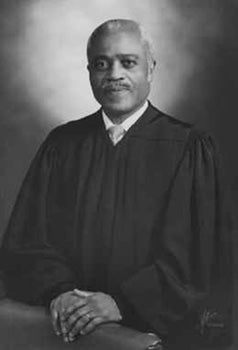 Charles M. Stokes, who assisted the
Bremerton branch of the NAACP.
Charles M. Stokes, who assisted the
Bremerton branch of the NAACP.
Blacks in Washington saw some of their own finally find places in the corridors
of power. In 1950, the Walkers' friend, civil rights attorney Charles M. Stokes,
became the first black state legislator in the history of King County. A staunch
Republican, Stokes championed the Civil Rights Omnibus Bill, one of the most progressive
civil rights measures in the nation. He went on to become King County's first black
district court judge. "He was flamboyant, articulate and brilliant and just an outstanding
lawyer and a wonderful human being," says Charles Z. Smith, who in 1988 became the
first ethnic minority on the Washington Supreme Court. A former King County deputy
prosecutor and Superior Court judge, Smith knew Stokes well.
Black activists in Bremerton and Seattle were close allies. In addition to the Urban
League and the NAACP, Seattle had an activist chapter of the Civil Rights Congress.
The Walkers attended those events whenever they could.
By the end of the war, most of the whites-only signs in Bremerton had come down.
However, an undercurrent of racism remained. The U.S. Supreme Court's landmark 1954
decision on school desegregation galvanized the modern civil rights movement. Everywhere
in America blacks were still fighting for equal opportunity two centuries after
the right to rise had been declared self-evident. As a boy, Lincoln memorized a
history of the United States by an Irish immigrant named William Grimshaw, who noted
with surprise and regret that the "colonists turned a blind eye to slavery despite
lofty words." Grimshaw asserted, "Let us not only declare by words but demonstrate
by our actions that 'all men are created equal.' "
All that was lost on the Bremerton drug store owner who on September 18, 1954, refused
to let James Walker buy a cup of coffee at his soda fountain. "I didn't serve niggers
in Texas," he declared, "and I'll go to hell before I serve them here."
To hell you say? The Bremerton branch of the NAACP was pleased to oblige. There
was a grade school about a block away from the drug store, "and the little colored
kids if they went down and got an ice cream cone they had to go outside, no matter
what the weather was," Mrs. Walker says. "But the little white kids could sit at
the counter. This is wrong!"
After a strategy session and a call to Philip Burton, another revered Seattle civil
rights attorney, James and his friend Whittier Johnson volunteered to throw down
the gauntlet. The drug store man "didn't know he was set up because we had white
and black witnesses" there when he refused to serve the two men, Lillian recalls.
Burton immediately filed a Kitsap County Superior Court complaint asserting that
James Walker's civil rights had been violated. "We got telephone calls at 2 and
3 o'clock in the morning, threatening us, saying what they were going to do if we
didn't drop the case," Mrs. Walker recalls. "They'd say, 'We know you're in there!
You niggers had better come out!' " White neighbors vowed to protect them.
The druggist settled out of court with the Walkers and grudgingly agreed to cease
discrimination. One more seemingly small step on the road to equality.
A larger one took place 2,100 miles away the next year when Rosa Parks wouldn't
go to the back of the bus. She was arrested, and young Martin Luther King Jr. helped
organize a citywide bus boycott by blacks. James and Lillian Walker watched the
newsreels and knew they were now part of something big.
Housing was a major sticking point. In Washington State, the push to remove the
covenants that denied minorities equal access to housing began in the late 1940s
and finally came to pass in the 1960s when the movement was at its zenith. State
Rep. Sam Smith, a charismatic black Democrat who had defeated Stokes in 1958, forged
a bipartisan coalition to "see the light" and pass a state open housing law in 1967.
De facto housing segregation via "gentlemen's agreements" and "redlining" existed
in Bremerton well into the 1960s, according to the Walkers. In the mid-1950s, when
the Walkers had two young children - Jimmy, born in '45 and June five years later
- they went looking for a bigger house. The real estate man tried to steer them
to Navy Yard City along Sinclair Inlet where many black families lived. But Lillian
had spotted a nice house in another neighborhood. It had a "for sale" sign in the
front yard. "So I called him and told him about it. And he said, 'Well, that's $28,000.'
" That was way beyond their means, but Lillian shot back, "I don't remember that
we gave you a price that we couldn't meet." He never called back, so she called
another real estate agency, made an appointment to see the house and asked two white
friends, Marie and Jim Morris, to go along.
The real estate man got out of the car, strolled up to Marie and said, "Hi, Mrs.
Walker." Marie said, "I'm the maid. This is Mrs. Walker." Lillian loved watching
him squirm and James could hardly contain himself. "The guy hem-hawed … I bet he
made five trips, up and back, up and back, to the house." Finally, He showed them
the house, which was lovely. "After we got through, I said, 'We'll let you know
whether we want it or not.' "
"We felt that we were moving forward," Mrs. Walker says of the post-war years. "At
least we had moved off of the (whites-only) signs. But there were other issues,
like the paper would not print a Negro picture on the front of the paper unless
he had committed some terrible crime, like raping a woman or killing someone." In
the 1950s, they say things changed at The Sun, thanks to reporters Gene Gisley and
Adele Ferguson. Gisley, who died in 2007, had an open-door policy to the public
when he became The Sun's editor in 1969. "He was really a good guy," Mrs. Walker
says. "If we went down to the paper, we could either talk to him or Adele. And we
knew that we were going to get what we wanted." All they wanted, she adds, was "to
be treated like everyone else in Bremerton." Ferguson, who arrived in town about
the same time as the Walkers, says Lillian has always been a livewire, and "the
black people in Bremerton were first-rate folks."
Lillian and James had part-time janitorial jobs at a bank as well as the theater.
They also took classes at Olympic college, he in electronics, she in bookkeeping,
typing and shorthand. By the time he retired after 38 years with the federal government,
James had parlayed his appetite for learning, his attention to detail and affability
into a post as assistant office manager for the Defense Contract Administrative
Service in Seattle. "I always encourage everyone to get as much education as they
possibly can," Lillian says. "That is something no one can ever take away from you."
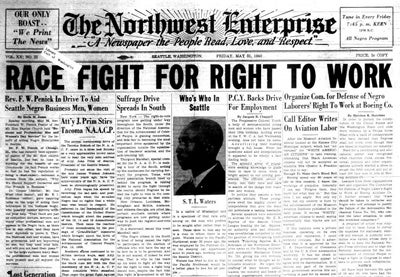 A front page from a 1940 edition of
Seattle's leading black newspaper. James Walker was its Bremerton business manager.
A front page from a 1940 edition of
Seattle's leading black newspaper. James Walker was its Bremerton business manager.
In the early 1950s, James was also the part-time Bremerton-area business manager
for The Northwest Enterprise, a black newspaper based in Seattle. Lillian helped
him with the billing and distribution and held several office jobs over the years.
She was a bookkeeper for a real estate company in Tacoma, and for the Kitsap Community
Action Program.
James was a Mason; Lillian was in Eastern Star. When they began raising Jimmy and
June, they immersed themselves in the PTA, Campfire Girls, Cub Scouts, Boy Scouts
and their church - Ebenezer African Methodist Episcopal, which they joined in 1941,
shortly after arriving in Bremerton. Asked what sort of church work she has done
over the past 68 years, Lillian chuckles and says, "The missionary women of the
church went to a meeting in Seattle one day, and they asked me, 'Well, what office
have you held in the church?' I said, 'I've been everything but the minister!' I
was trustee. I was a steward.
I was the secretary of the Sunday School. I've been on the Trustees' Board, and
I've been on the Steward Board, and I've been the president of the Missionary Society."
She was also a founder and president of Church Women United. "I want to make it
clear," she says, "that when we arrived I met a lot of white people who weren't
racist — especially the women who I helped start the Church Women United. That was
women from every church, black and white. At one time we had about 150 members.
… You know, I tell people, I have as many white friends as I have black friends."
Among the kids who attended Ebenezer, Mrs. Walker was a legend in her own time as
the decorum enforcer. "When we were young, we were afraid of her," says Althea Colvin,
whose parents, Al and Hazel, were good friends of the Walkers. "If anybody acted
up in church, Mrs. Walker - she didn't care whose child it was; she didn't have
to know you - she would pick the child up and take it outside. I don't know what
she did, but when they came back in that child wouldn't say a word! … All the kids
who went to church there, they respected Mrs. Walker. She could just look at you."
In the 1980s, Al Colvin became Bremerton's first black City Council member. He was
already one of Kitsap County's most respected citizens. But things were different
in 1946 when he returned from the war and sent a plane ticket to his teenage sweetheart
in Alabama. Hazel Colvin recalls being surprised to encounter overt discrimination
in Bremerton. She thought she'd left that behind. Pregnant and feeling unwell, she
went to the same drug store where James Walker had been refused service. She just
wanted a cool drink, but "sat there and sat there" as the waitresses ignored her.
There were speed bumps - and detours - on the road to equality in Bremerton and
from sea to shining sea. But Althea Colvin, who graduated from high school in Bremerton
in 1966, says she never experienced racial prejudice in girlhood - the legacy of
the Walkers, her parents and the other civil rights pioneers in Kitsap County, black
and white.
Hazel Colvin says, "Lillian Walker is the same person today as the person I met
in the 1940s. She has always been a real energetic person. … She and James have
been the most wonderful friends." Althea seconds the motion: "Over the years, she's
been the most loving, humble caring person and whenever I see her, she just loves
to see me. She calls Mom all the time to see that she's OK."
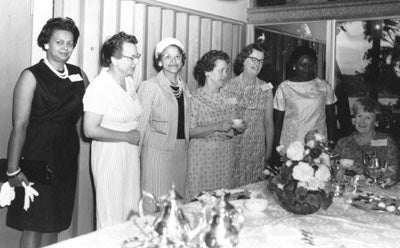 The annual tea of the Carver Civic Club
in 1966. Hazel Colvin is at left, Mrs. Walker third from left, and Gert Joseph fifth
from left.
The annual tea of the Carver Civic Club
in 1966. Hazel Colvin is at left, Mrs. Walker third from left, and Gert Joseph fifth
from left.
Mrs. Walker, who seems to be everywhere at once, was treasurer of the Bremerton
Garden Club and has been active in the Kitsap County Democratic Party since the
1940s, serving as a precinct committee woman in the 1970s. She was a member of the
board of the Carver Civic Club, founded in 1948 as the Bremerton affiliate of the
National Association of Colored Women's Clubs. The association dates back to 1896,
"a time when Negro women were seen as chattel," Mrs. Walker notes. The club disbanded
as its members aged, but Mrs. Walker is helping Dianne Robinson revive it. They
now have 14 members. "I just watch Mrs. Walker and try to follow her lead," Robinson
says. "She knows parliamentary procedure like you wouldn't believe."
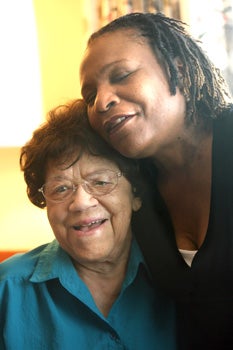 Linda Joyce, Executive Director of the
Kitsap County YWCA, hugs Lillian Walker, a charter member, at a 2008 event to celebrate
the Y's 60th anniversary.
Linda Joyce, Executive Director of the
Kitsap County YWCA, hugs Lillian Walker, a charter member, at a 2008 event to celebrate
the Y's 60th anniversary.
Carolyn J. Yaschur, Kitsap Sun
Helping to found the YWCA of Kitsap County is one of Mrs. Walker's proudest achievements,
and its role has expanded. In the 1970s, two staff members at Olympic College had
an idea for a shelter for women and children who were victims of domestic violence.
They formed a partnership with the YWCA, and "ALIVE" - Alternatives to Living In
a Violent Environment - was born. It was controversial at first. Some said that
wasn't part of the YWCA's core mission, but Lillian wasn't buying that. Too many
women "just had nowhere to go" to piece their lives back together, she said. Others
endured abuse in silence because they were afraid and had no one to tell. Her own
father had a temper that could turn abusive, and her mother - remember, she had
suffered brain damage at the hands of her stepfather - "just took it." Mrs. Walker
recalls, "When James and I were getting married I said, 'I need to tell you something.
… If you ever hit me, you better knock me out. Make sure I'm out cold, and be gone
when I come to …' " James said, "Honey, I wouldn't hit you! I love you." And Lillian
said, "I know. I thought my dad loved my mother. But I'm telling you, I will not
take a beating off of anybody."
Lillian Walker and her sisters in arms "raised the bar for women's involvement in
Kitsap County," Linda Joyce, the executive director of the YWCA, said at a 60th
anniversary celebration in 2008. Congressman Norm Dicks, a Bremerton native, was
there, too, to salute one of his biggest fans. "Lillian has been one of the pillars
of our community," he said, "someone we all respect so much. It's great to see her
get the recognition she has long deserved. ... The YWCA has done such a good job
in eliminating racial barriers and supporting diversity in our community. … And
domestic violence, this is a subject that in our lifetimes, Lillian, wasn't even
talked about!"
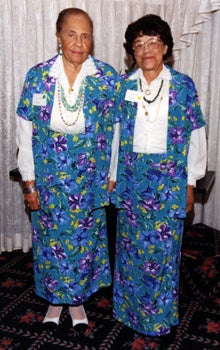 Lillian with her best friend, Marie Greer.
Lillian with her best friend, Marie Greer.
Mrs. Walker's eyes filled with tears as she received a standing ovation. "You have
qualities," she told the crowd. "I have qualities; we need to bring people together
for the best of the community. That's the way I work on anything I work on. If it's
going to better you, it's going to better me. The Golden Rule has always been my
motto."
Joyce said, "She's been there at every twist and turn. Marie Greer has passed away,
so Mrs. Walker is now our only surviving charter member. She reminds us of the commitment
and vision of the ladies who were the backbone of this organization."
Mrs. Walker and Mrs. Greer, who died in 2008 at the age of 94, were two peas in
a pod - active in the NAACP, the YWCA, the Carver Civic Club and Ebenezer A.M.E.
Church. They became even closer after they lost their husbands. "They went everywhere
together, did everything together and even dressed alike," Councilwoman Robinson
says. "I called them 'The Gold Dust Twins.' "
Lillian and Marie met in the fall of 1941 when she and James joined Ebenezer. In
1943, they helped organize Unit No. 1134 of the NAACP. Mrs. Walker is now the sole
surviving charter member. Her brother, Lewis Allen, was chairman of the Fair Housing
Act program for the NAACP and served as president of the branch in the 1950s. Loxie
Eagans, its 10th president in the 1960s, was deputy Equal Employment Opportunity
officer for the shipyard and a vigorous civic leader. Over the years, the branch
has hosted a number of prestigious visitors, including Roy Wilkins, national director
of the NAACP. It staged a march in the 1960s in support of Dr. King's push for voting
rights and an end to Jim Crow laws. In the 1970s it established a credit union that
was Al Colvin's pride and joy. The branch also developed a strong partnership with
Olympic College, launched scholarship programs and developed a nationally recognized
Youth Chapter. It successfully lobbied Kitsap County to establish an Affirmative
Action policy. In 1986, when the City of Bremerton balked at making Martin Luther
King's birthday a holiday, the NAACP jawboned compliance, with its dynamic former
president, Larry Greene, leading the charge.
"We've come a long way in Bremerton," Mrs. Walker says, "but you can't stop fighting
ignorance."
Mayor Glenn Jarstad appointed Mrs. Walker to the Regional Library Board in 1972.
She served for seven years, particularly proud to have played a key role in the
design and construction of the new Sylvan Way Branch, which opened in 1978. She
was board chairman at the time. She and James were active in promoting senior citizen
programs and served two terms apiece on the Kitsap County Area Agency on Aging Advisory
Council.
In 1997, Kitsap County's Martin Luther King Memorial Scholarship Fund Committee
named James and Lillian Walker "MLK Citizens of the Century" for producing a total
of 100 years of service to the community and the nation. James said he was surprised
because he didn't think the work they'd been doing "was such a big deal." Lillian
added, "We knew we had a lot of friends, but getting this award for doing what we
thought was right … well, I feel really honored."
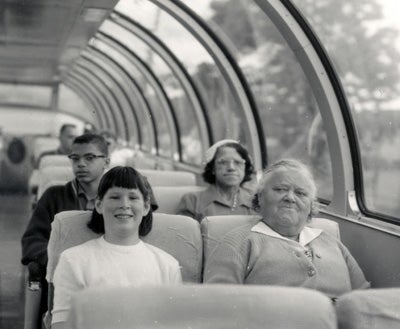 A train trip in the 1960s: James Jr.
and his mother sitting behind his sister June and their grandmother, Hazel Allen.
A train trip in the 1960s: James Jr.
and his mother sitting behind his sister June and their grandmother, Hazel Allen.
Their son says it was largely unspoken but well understood that his parents had
high expectations when it came to education. "I was always a person who wanted to
push ahead," the epidemiologist says, "and I had my internal goals, but they recognized
the importance of education and provided opportunities. … Family and family life
was always important to them." They were also "friendly, sociable people, and they
tried to make friends with strangers and defuse any situations." Like Althea Colvin,
James T. Walker Jr. feels he grew up "sheltered from some of uglier parts of life"
because his parents and the other Kitsap County civil rights pioneers had already
challenged "a lot of the institutional racism."
Alyce Eagans, who arrived in Bremerton in the 1940s right after she graduated from
high school in Arkansas, joined the NAACP as a teenager and went on to become its
president. Her future husband, Loxie, and the Walkers were role models. "James was
very quiet - not nearly as talkative as Mrs. Walker!" she says. "But he had a great
sense of humor and was a very effective leader. And Mrs. Walker was something else!
She just didn't sit back. She made things happen. She's been a livewire all her
life. Even today, at 95, she can think of more things than I can. Her brain is always
working. She's just amazing!"
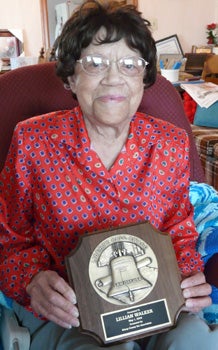 Lillian with her Liberty Bell Award.
Lillian with her Liberty Bell Award.
Lillian Walker is "deeply humbled" by all the awards she has received lately, quipping
that she has just "out-lived" most everyone else in the running. The PTA gave her
its Golden Acorn. The YWCA gave her its Founder's Award and the Democrats presented
her their Lifetime Achievement award. The NAACP calls her "a living treasure." She's
running out of wall space for all those plaques. The 2009 Liberty Bell Award from
the Kitsap County Bar Association is one of which she is particularly proud. Her
friend Robin Hunt, a Court of Appeals judge, nominated her, saying that Mrs. Walker
has "contributed in countless ways to the effective functioning of our government
and promoted better understanding of our Constitution, the Bill of Rights and the
rule of law. Her courageous persistence to insist on equal rights has brought about
change in our community. … She is the living embodiment of Lincoln's Emancipation
Proclamation and Martin Luther King's dream. And she has accomplished these goals
without rancor, but rather with an attitude that others simply needed to be 'educated.'
"
Washington Attorney General Rob McKenna was awed by Mrs. Walker's eloquently humble
acceptance speech as she received the Liberty Bell Award. He said it was the closest
he would ever come to meeting Rosa Parks.
"This wonderful life"
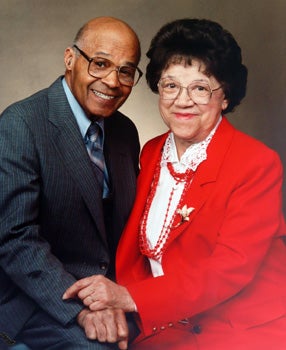 James and Lillian Walker in the 1990s.
James and Lillian Walker in the 1990s.
With an assortment of aches and pains, Lillian Walker has her good days and bad
days. But the good ones are lovely, especially when friends stop by, and the bad
ones "not so bad." She says she knows she will be leaving Planet Earth for a better
place "pretty soon," but she's thankful for "this wonderful life" she has lived.
Oh how she misses James, who died at 89 in 2000. They were married for 59 years.
"If I had searched the world over I couldn't have found a better mate." Sometimes
it seems as if he's still here. "The other night I looked over (at his picture)
and I could see him coming through the door. Or, I go to bed… 'OK, honey, I got
the bed warmed for you!' And he says, 'OK, put your cold foot up on my leg.' That's
what I heard for all those years. Now I've got to put on socks."
Elwood and Marie Greer are gone, too, and Loxie Eagans and Al Colvin. But the memories
are still so vivid, and she has younger friends like Alyce, Judge Hunt and Councilwoman
Robinson who adore her and check in often. Her daughter June in Tacoma is attentive,
and James Jr. calls often. A young woman she has known from church interviewed her
for a class at the college, which was gratifying. She worries about the kids today.
Robinson, to their dismay, has a hard time getting younger people interested in
the NAACP and black history. The Kitsap County Black Historical Society is a labor
of love for the councilwoman, and Mrs. Walker says what she has accomplished is
"just terrific - collecting all those pictures and documents. I just can't give
that girl enough credit. If every kid - and not just black - in Bremerton, in Kitsap
County, in Washington State, if they could read what she has done and really listen
to what she's done, they'd have a lesson. I mean a brilliant lesson."
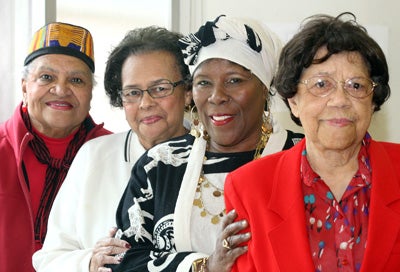 From left , Alyce Eagans, Hazel Colvin,
Dianne Robinson, and Lillian Walker at the Kitsap County Historical Society Museum's
presentation on "Segregation and Civil Rights in Kitsap County." Carolyn J. Yaschur,
Kitsap Sun
From left , Alyce Eagans, Hazel Colvin,
Dianne Robinson, and Lillian Walker at the Kitsap County Historical Society Museum's
presentation on "Segregation and Civil Rights in Kitsap County." Carolyn J. Yaschur,
Kitsap Sun
Robinson visits schools, trying to impress on young folks, especially minorities,
that people like Mrs. Walker and Rosa Parks put their very lives on the line to
secure equal rights. "I'm just so proud to say she's my friend," Robinson says.
"I worry every day about where the next Lillian Walker or Marie Greer or Loxie Eagans
is going to come from. Mrs. Walker always says, 'Who's gonna take over for us?'
"
"When you read the history of the things they did you're inspired. They made a real
contribution to making this a better community," Robinson adds. "Growing up in Pensacola,
Fla., the Community Center clubhouse taught me so many things. I learned how to
dress; what clothes to wear; to crochet. I went to camp. I learned how to kill a
snake! And I was connected to the older people in the community. There wasn't a
day that I didn't go knock on some old person's door and say, 'Ma'am can I help
you with anything today? You need your yard raked?' The childhood that I had growing
up in a community and being involved and having role models like Mrs. Walker and
Mrs. Greer was so important. Those two ladies were so alike. When I first got here,
they said, 'Well what do you know about black history?' Then they saw what I was
like and what I was going to do, and they said, 'Well, Dianne, that's very important.'
I want to be able to tell these stories so that they're preserved and to show that
people here in Kitsap County have made a big contribution, so that people can understand
how things were and how they got changed."
Mrs. Walker listens and nods. "This is right," she says. That's one of
her favorite phrases.
So, with her 96th birthday not far off, "Lord willing," what advice does she have
for us and her six grandchildren and three great-grandchildren? "Don't complain.
If you've got something to complain about, well, work at it and make it better.
… And, treat everybody right. I don't care who or what they are, treat them right.
You don't have the authority to mistreat anybody, because that's why we are here
- to help each other. If you can help somebody, help them."
And what would she say to kids of all colors who often seem to take for granted
the freedoms she fought for? "I'd try to tell them, 'You don't know what you're
doing. … Know your history! We have fought for you to have the rights to go in and
sit down and eat, to go and apply for a job.' "
That's vintage Lillian Walker.
John C. Hughes, The Legacy Project, 2009